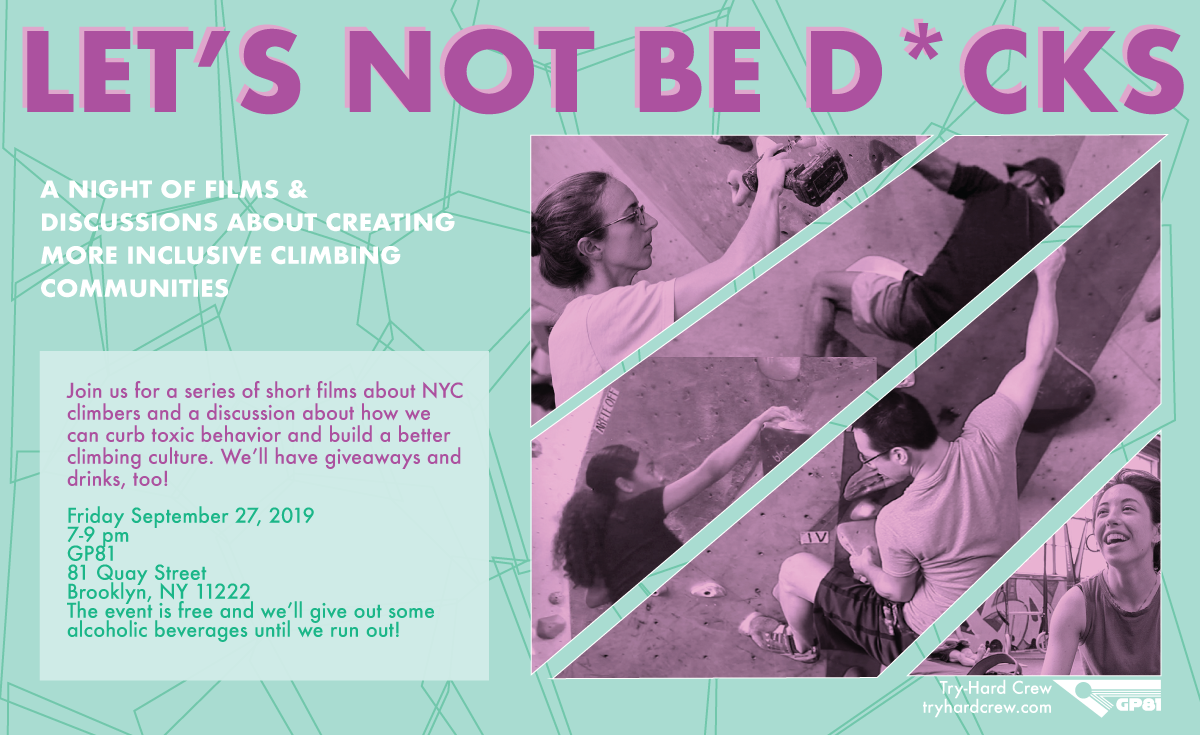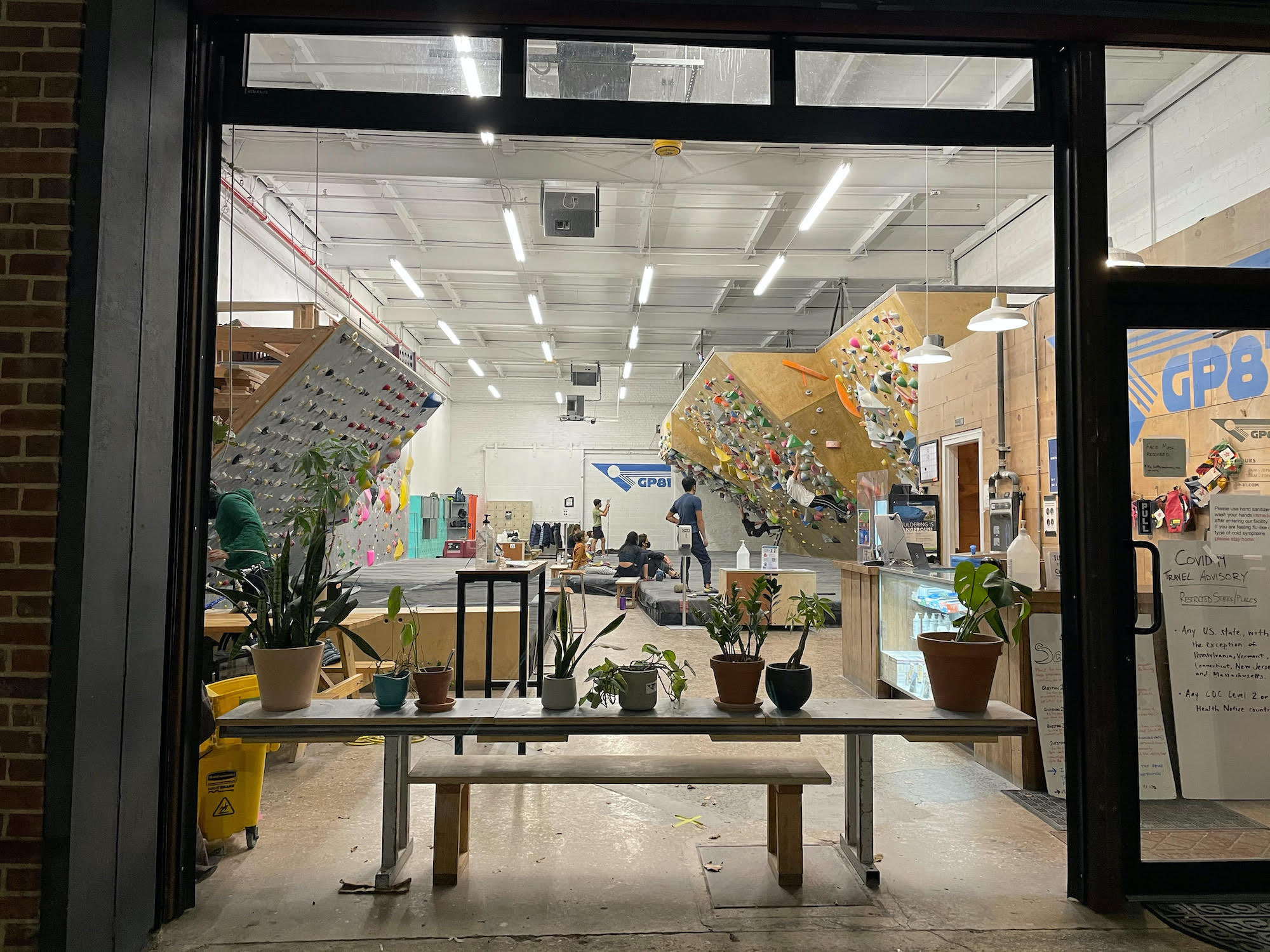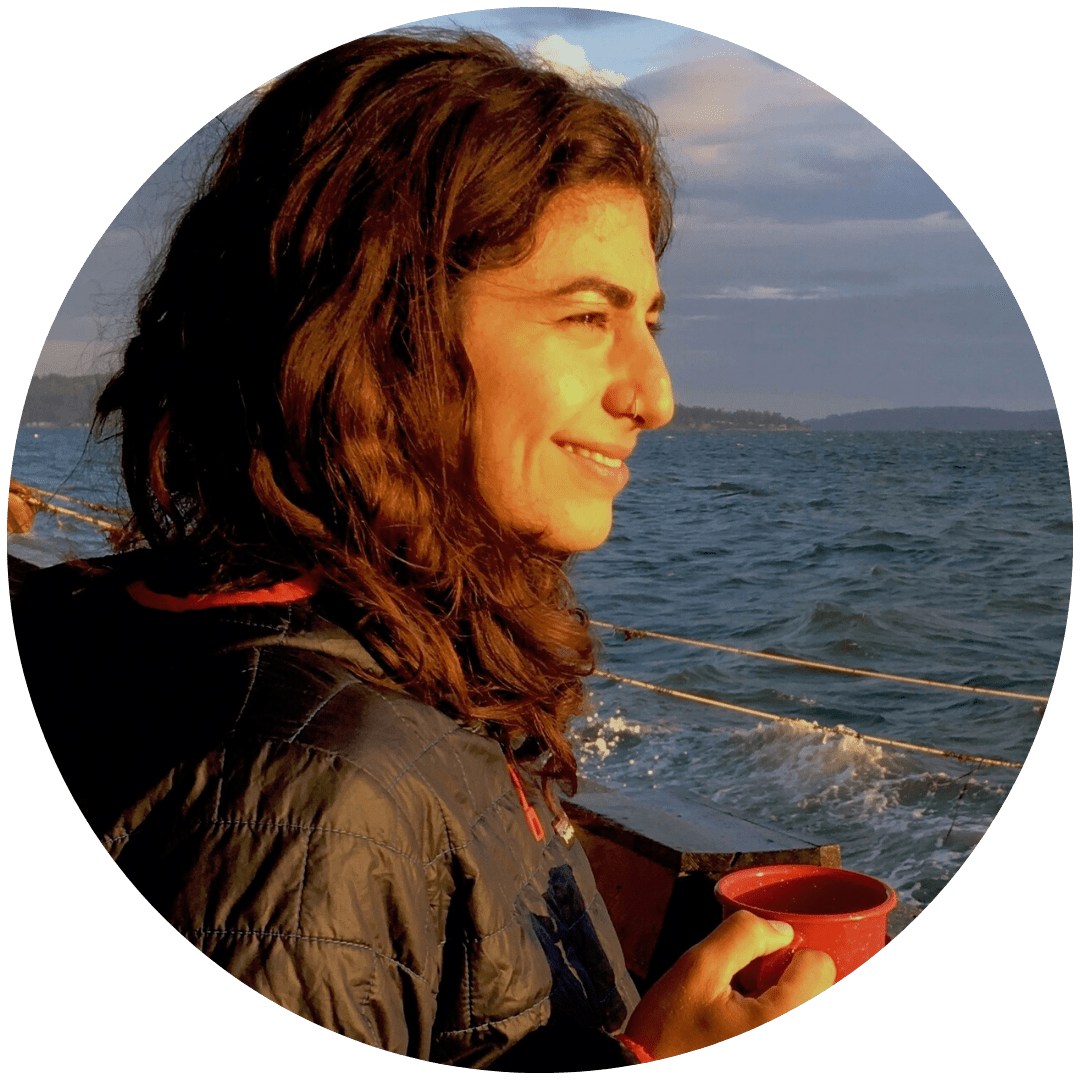Projecting Anti-Racism: A Case Study of GP81 and Try-Hard Crew

The Climbing Wall Association’s next installment of “Projecting Anti-Racism” is a case study of a bouldering gym and a local grassroots climbing group that explores how to build community in 2020. GP81 is a climbing gym in Brooklyn, New York, and Try-Hard Crew is a group that hosts monthly meetups, creates programming, and models ways of being in community to inspire more joy and empathy in climbing culture for women and gender nonconforming people.
When he first began GP81, Cliff Simanski had a clear vision for the kind of gym that he wanted to build – one that would serve climbers who really just wanted a space to climb, train, and be together. No birthday parties. No frills. Since its inception, and along with the help of partner Julian Acevedo, the gym has been embraced by the community.
Cliff had spent the years prior working in basically every other gym in New York City before establishing his own. “I watched the prices of the gyms I was working at start high and then just keep going up. I thought, well, I just wanna go someplace and rock climb. I’d rather pay less and not have a fancy sauna,” Cliff told me in an interview. And since his gym isn’t looking to establish the same considerable margins, he has been able to maintain an affordable drop-in rate and membership fee relative to the rest of the city. Prior to the pandemic, he was even looking into having members who could afford to pay more do so in order to subsidize memberships for lower income climbers. Cliff rejected the mega-gym model in favor of an intimate space that can foster the kind of community he believes in.
I asked Cliff to tell me about deciding to work with Lam Thuy Vo when she approached him on behalf of Try-Hard Crew to see if he would be interested in hosting an event together. He explained:
“As the owner, I can just make the decision and we don’t have to sit down in meetings. It just reduced the whole process of someone like Lam coming up and saying, ‘We wanna host an event and we’re gonna call it ‘Let’s Not Be D*cks’ and I’m like, ‘Ok, would I have come up with that name on my own? Probably not. But if this is the name that you guys want, and this is the event that you’d like to host, then it’s nice to be able to say ‘Ok, let’s just do it.’ We don’t have to sit down and have all these meetings. It’s just made it so much easier to actually get things accomplished”.
Let’s Not Be D*cks was a night of film screenings that Try-Hard put together to explore and address toxic masculinity in climbing. The community filled the space at GP81, had drinks together, and tuned in to learn about the ways climbing culture can be more accountable to women and gender nonconforming people.
The event spoke for itself. Cliff went on to say, “I think even before we opened the event, we had more people interested in signing up for it than spots we had available – just from hearing that it was going to happen.”

Even though his space is more affordable relative to other gyms, Cliff still noticed a “clear lack of diversity”. When given the opportunity to support the founders of Try-Hard, Cliff accepted his role as facilitator and appreciated the opportunity to learn and grow in the process of working with the group.
Try-Hard Crew has had considerable success organizing events with GP81. Most notably, a routesetting clinic resulted in two apprenticeships for Black women with the gym. It also resulted in another member of Try-Hard being hired, even with very little traditional experience, by the new Vital Climbing that is opening elsewhere in the city. They are excited at the chance to have a more diverse routesetting team from their inception and have been consulting with Lam throughout their hiring process.
Try-Hard Crew brings a perspective and practice of being in community that GP81 facilitates. Together, they tackle the difficult and complex issues like sexism and toxic masculinity, racism, and other forms of oppression that keep people away from climbing gyms. They do this by having events as well as building more infrastructure, like apprenticeships, to tell people that don’t look like your “typical” climber they are included in the space.
“We’re modeling something that they didn’t think of before,” Lam told me in a separate interview. “It’s a very deep intentionality that comes with our work and we’re also hyper-focused when it comes to our work. We’re not here to change the entire industry. We’re here to change two or three people’s lives, maybe a handful of people’s lives, and make them feel more welcome in a gym. And that alone makes a huge difference.”
Grassroots and local organizations are uniquely positioned to offer this perspective to climbing gyms – they interact with the space as members and can advocate for the things that gyms have historically overlooked.
A fundamental truth of the community work of either Cliff or Lam is that the success of their work hinges on their ability to work together and optimize their unique strengths and privileges. There is a measure of camaraderie to them, having spoken with each about the other – they certainly like each other. More importantly, however, both are committed to ensuring that the community is prioritized above profit, and that the gym continues to evolve little by little for sustainable long-term change. Lam shared this about working with Cliff “The best thing that he said in terms of learning how to be a better routesetter is to actually watch other people climb. He said something like, ‘I can set the best route in my perspective that I could ever think of, but if no one enjoys it and no one climbs it, that really is not good.’ So he already has a baseline empathy,” and that is why, ultimately, Lam feels that she does not need to tiptoe around Cliff in order to justify the need for the work Try-Hard Crew is doing.
Both parties appreciate that the more successfully they can integrate diversity in the space, the more the community will thrive.“Not just give someone the experience of routesetting but hopefully give them a bit of a toolkit where they could take that elsewhere and either try to find a job with it or evaluate if that was actually a career path that they wanted to pursue,” Cliff explained to me. We acknowledged climbing culture has historically elevated white men significantly more than any other demographic.
Try-Hard Crew benefits from Cliff’s ability to share their vision without necessarily having all of the right language and education around anti-oppression himself. When it comes to his work, his plate is already quite full, “There’s always something else that needs to happen, and it’s really difficult to prioritize things beyond what’s going on at the immediate moment. Lam is really good about making sure we follow through with these things and having a routesetting clinic and doing these events, just like, creating those pipelines so that it’s easier for folks like myself to not have to start from square one every time.” He went on to explain how GP81 is able to “have a curriculum we can start to work with, and have someone that’s accountable to actually making the time to do these things. Because otherwise, it’s so easy to just keep working on what’s in front of you and if that never changes then you keep working on the same things.”
Lam maintains a similar perspective, “The only thing that is sometimes harder to get is for people to then do the thing. Because I think it’s not the resistance to doing the right thing, it’s actually a lot more how it falls further and further down the rung of priorities. I think that’s usually what I see when I see the death of initiatives.” Lam went on to explain, “As much as all of these institutions have been very flawed...I do think that there’s individual people in those institutions that have always done the right thing and I think that at GP81 that person that does the right thing just happens to also be the owner.”

Lam further acknowledged her particular context regarding where GP81 and Try-Hard are operating from. “You’re talking about urban centers where there is a higher concentration of people of different backgrounds living closer to each other and a lot of people in those centers will agree with you in theory [about the need for equality] but what they don’t often end up understanding is that it takes dedication over time and, again, I think that’s an action that has to be continuous. Diversity can’t just be a ‘nice to have’ it has to be a ‘must have’. And based on that, that means that for some folks, they don’t quite understand how much work goes into building that over time and maintaining that.”
Fortunately for this grassroots organization, Cliff does understand. “Making time for these kinds of things and actually making it a priority,” is how he phrased it, again, very similarly to Lam. Cliff elaborated on what it looks like on the gym’s end of facilitating these events, “Even with [Try-Hard] doing a tremendous amount of work it still takes a lot on our end. Doing the setting clinics, we have to get the routesetting team involved and they’re gonna have to do a little bit of extra work in the clinics, and maybe work some longer hours, or set some extra boulder problems and everyone’s been on board for it. It just goes to show that it takes a lot of people and it takes a lot of time. But just making sure that that holds the place of priority and being really open to hearing all the ideas and letting go of the reigns.”
When I asked what advice Cliff had for other gym owners, he expressed, “As a privileged white male there’s only so much that I can contribute outside of the resources that I have access to with the gym and with our community. So, taking a step back and providing what you can provide and just being available I think is really important.”
Both parties become animated in talking about their work together and in creating meaningful change one project at a time. Both seem content with their roles–Cliff as the gym owner with the ability to organize his team and host in his space as well as advocate for greater diversity.
He said, “I’m excited about it. Lam’s been such a big help. There’s so many things that I don’t understand about how to even do the work: from the language to use to where to get started and it’s been an exponential curve of figuring stuff out. I think I would always loop back to just being open and being available and being willing to learn and make your mistakes.”
Lam, who has a fulltime job as a journalist, added, “There are, of course, people who don’t care as much and don’t consider diversity in any practices that they do, and I solely as who I am cannot change their minds, but there are always, on the other hand, people who have listened to me in the past and are learning by looking at what we’ve been able to do together.”
We need each other to do this work to stop perpetuating cycles of harm. Community groups are able to be hyper-focused and help create spaces that center empathy and thrive with the continual support of climbing gyms. Be sure to check out this article by Lam that gives more insight into her experience of climbing as a way of healing her relationship to her body. Let’s keep supporting gyms and each other right by adhering to local health protocols until the day we’re able to gather in-person again to keep doing this important work.
About the Author
 Anaheed Saatchi is a queer and non-binary writer and community organizer. They cover themes of social justice, diaspora, the outdoors industry and identity politics. In 2018, they co-founded the rock climbing initiative BelayALL, based on the unceded territories of the səl̓ilwətaɁɬ təməxʷ (Tsleil-Waututh), Skwxwú7mesh-ulh Temíx̱w (Squamish), and šxʷməθkʷəy̓əmaɁɬ təməxʷ (Musqueam) nations. Examples of their work can be found in Alpinist Magazine and online at Melanin Base Camp.
Anaheed Saatchi is a queer and non-binary writer and community organizer. They cover themes of social justice, diaspora, the outdoors industry and identity politics. In 2018, they co-founded the rock climbing initiative BelayALL, based on the unceded territories of the səl̓ilwətaɁɬ təməxʷ (Tsleil-Waututh), Skwxwú7mesh-ulh Temíx̱w (Squamish), and šxʷməθkʷəy̓əmaɁɬ təməxʷ (Musqueam) nations. Examples of their work can be found in Alpinist Magazine and online at Melanin Base Camp.
